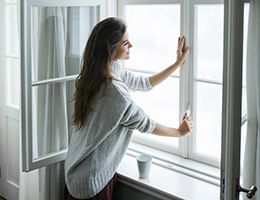Health library
Back to health libraryHow healthy is the air in your home?

We spend a lot of time at home. So it's important to make sure the air we breathe there is clean.
Indoor air pollution matters to your health. Unhealthy air can worsen a lung disease, like asthma, notes the American Lung Association. Or it can trigger allergy symptoms. Some indoor air pollutants can cause headaches or irritate the eyes or throat. Some may even increase the risk of cancer.
But there are steps you can take to breathe better at home.
Air-quality offenders
Many things in—and outside of—your home can add to bad air. Here are a few common triggers and what you can do about them.
Mold. Mold spores thrive in damp places, such as kitchens, bathrooms and basements. These are places where water leaks and high humidity commonly occur.
What to do: Lower the humidity level in your home by fixing any plumbing leaks under sinks and dishwashers and around laundry units, toilets, tubs and showers. Get more tips on keeping your home mold-free.
Dust mites. Household dust contains these tiny bugs, which many people are sensitive to.
What to do: Keep up a regular cleaning routine. Dust often. Vacuum floors and mattresses weekly. Wash bedding and area rugs weekly in hot water. And try not to let clutter build up. Dust, dander and other debris can easily accumulate around household clutter, such as old newspapers and magazines.
Strong smells. Strong fragrances from scented candles, air fresheners and wax warmers can be irritating to some people.
What to do: Avoid scented products if they bother you.
Fuel-burning appliances. Gas stoves, water heaters and fireplaces can leak fumes, such as carbon monoxide, if they are improperly vented.
What to do: Have your heating system inspected yearly for deadly carbon monoxide leaks.
Chemicals. Cleaning products, as well as new furniture, carpet and flooring, can release harmful gases called volatile organic compounds (VOCs).
What to do: When remodeling your home, choose products that emit a low level of VOCs. And see if the materials can be aired out before they are installed. When buying cleaning products, read the labels and choose those with fewer VOCs. And when using them, open windows and run fans to keep the area well-ventilated.
Radon. This is an invisible gas that causes lung cancer. It enters homes through foundation cracks and can build to dangerous levels.
What to do: Test your home for radon. Test kits are sold at hardware stores. High radon levels can be fixed.
Tobacco smoke. Even if you don't smoke yourself, secondhand smoke can lead to lung cancer and heart disease.
What to do: Enforce a no-smoking policy. Don't let anyone smoke in your home. If you need help quitting, ask your doctor.
Reviewed 2/20/2025
Sources
- American Lung Association. "How to Know if Your Air Is Unhealthy." https://www.lung.org/clean-air/at-home/how-to-know-if-your-air-is-unhealthy.
- American Lung Association. "Indoor Air Pollutants and Health." https://www.lung.org/clean-air/at-home/indoor-air-pollutants.
- American Lung Association. "Protecting Yourself from Air Pollutants at Home." https://www.lung.org/clean-air/at-home/keep-pollution-out-home.
- Asthma and Allergy Foundation of America. "Indoor Air Quality." https://aafa.org/asthma/asthma-triggers-causes/air-pollution-smog-asthma/indoor-air-quality/.
- Asthma and Allergy Foundation of America. "Why Healthy Indoor Air Quality Is Important." https://community.aafa.org/blog/why-healthy-indoor-air-quality-is-important.
- Centers for Disease Control and Prevention. "Improving Ventilation in Your Home." https://www.cdc.gov/coronavirus/2019-ncov/prevent-getting-sick/Improving-Ventilation-Home.html.
